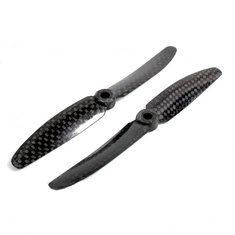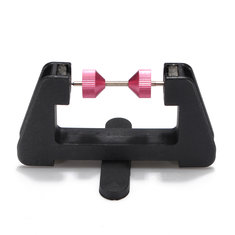This is a light introduction into it for those that want to start getting into the technical aspects. If you just want to go and have fun, then this is probably an entry you will want to skip.
Some might call them rotors, airscrews, whatever. I am not going to go into a lengthy detailed scientific discussion on aerodynamic theory that is over most peoples heads (myself included). I am just going to mention the short and basic things that we should keep in mind. The propeller is basically a wing, The wing can have many different shapes. The shapes determine what the desired performance is.
There is no 'perfect' design. To gain an advantage in one way, it often costs you in others. This is another of the grand compromises that there are so many of in most aircraft. If you look at wing designs, the long slender wing has a greater efficiency in lift. but at a certain point as we design them longer, it is difficult to give it enough strength. And there is more drag. The thickness and shape (Planform (NACA) Chord (distance front to back) all affect what the wing will be better at. The profile is also a factor as seen in the illustration above. The far left is a basic standard propeller, a 'jack of all trades'. The next two are a swept forward and a swept back design. The fourth one is called a Scimitar blade. The advantages to that are in the way it deals with the tip vortices (spiraling airflow). Generally on the scales we are working with, they offer little if any advantage. The one on the far right is a newer design that seems to offer advantages for us. I'll explain why at the end of this entry.
You have to remember that the root of the propeller (nearest the middle) although turning at the same speed as the rest of the propeller is actually travelling less of a distance per revolution. It is therfore effectively travelling through less air. As we get to the tip, it is going very fast, At some RPM, the tip can be breaking the sound barrier. in the above illustration, we can see that propellers are at different angles depending on how far from the hub it is. So if you were designing a propeller, you want a shallow wing design that is meant for very high speeds. and near the root, you want a broad wing that is at a steep angle to grab all the air it can.
If we look at a regular aircraft wing, there is an average to what the whole wing is angled at and shaped at as well as how thick it is. This is called the "Mean Aerodynamic Chord" or MAC.
Propellers for models are mostly listed in the form of '1104' for example. That means it is an 11 inch diameter propeller and the MAC is at an angle of 04. The '04' is not degrees but a relative angle for comparison. So a 04 is shallower than a 05 but less than a 03, etc. we call it the 'Pitch' of the prop.
The ideal prop configuration is determined by what engine is turning it. If you have too big a prop for your motor, it will not be able to get it to the speed where it works best. And also consider if you put too big a prop on your quad, it may not be able to turn without hitting something on the craft.
How Many
The next fun to know thing is how many blades it has. That would seem like something simple and it can be. But now you have to consider efficiency. The most efficient would be a single blade. propeller. But the thrust from it would be in a spiral and would shake the plane (assuming you could balance it properly) , A 2 blade design is the most logical choice. now IF you need the clearance, you can go down a size and go to a 3 blade prop. You will gain the clearance but the prop will not be as efficient. It will turn a bit slower and make the motor work a bit harder. This will cut down your flight time on a quad. The same goes again for a 4 bladed or more design. Airplanes use the multibladed designs because the size of prop that the engine can turn would be impractical. The propellers would be hitting the ground. The V-22 Osprey has a large 3 bladed prop because it can tilt them out of the way. It could be more efficient with a 2 bladed design, but then the wings would have to be several feet longer and the RPM would be high it would be noisy.
Now some of you might be thinking "Hold on, what about the turbine type ducted fans?" They turn at an extremely high speed, and they are in a shroud that helps direct the air to the blades better. But in a thrust per watt of power basis, they are much poorer on efficiency. They are better at high speed flight too. A propeller can really bight into the air at lower speeds. . For an example. your electric fan, It moves the air in the room. It moves a lot of air. but you can't blow up a balloon with it.



Propeller materials:
Propellers can be made of wood, various types of plastic or metal. In this hobby metal props are not used and that is a good thing. There is no reason to have a metal blade on these and they can be dangerous.
Wood is ok but not as resiliant as the plastic types.
Of the plastic types, there is a soft plastic (almost a vinyl and soft) they are only used on the smaller indoor types. They are less likely to damage anything or hurt someone.
Hard plastic (Nylon) is the most common. it offers light weight. stiff and strong.
It is affordable, pretty consistant in size and shape but still retains a small amount of 'give'. It can cause injuries at high RPM
Carbon Fibre is on the larger and higher end props. It is the strongest and stiffest (short of metal) so it's shape and angles remain constant. It is also the most expensive and it is stiff enough that you can get seriously injured if at high RPM.
Once you get to 250mm class or larger, you will be dealing with only the nylon and the carbon fibre props.


Get Balanced
It is important to balance your props on the 250mm and up, even if they came attached to your Quad. An unbalanced prop will shake the airframe and could cause damage. It can also be a cause of 'jello' effect when taking video. A prop balancer is pretty cheap and I consider them essential. There are many types. I prefer the magnetic type, a point on one side is drawn to a magnet, another magnet pulles on the other side but does not quite touch. This is the lowest friction and lets you see where you have an imbalance the best in my humble opinion. When balancing, you can sand off a tiny bit of material from the back of the heavy side, at the inner 1/3rd. Or you could apply tape to the light side (it's not a good idea to sand Carbon Fibre props. If the dust gets into your lungs, it does not break down).
If the prop halves are not equal in length than you can carefully sand the tip to make them match, Just make sure you keep the same profile. The amount of material that has to be removed is very little. If it's a big difference, then you might want to retire that prop. Some people advocate adding weight (not just tape) to the prop. In my opinion, if that weight ever 'let go' it would probably be flung pretty far and pretty fast. The potential for injury make me shy away from this.
Summary
Ok, I took a few liberties with the science there to make it simple to understand. There is a lot more to all this but it doesn't really help us out in this hobby. So as a rule, try to stick with what the motor manufacturer suggests for prop size and pitch. If you need to go outside that, then I suggest you stick with changing the diameter no more than one inch up or down. If you need more clearance, then perhaps go down a size and make it a 3 bladed prop. This should work for your application but try and measure. That bigger prop might give you a few hundred grams more lift but shorten the battery life by a few minutes.
This is all probably more than you ever cared to know, yet I have barely scratched the surface of this subject.
I promised early on that I would explain why the prop on the far right of the first illustration is a better design for our hobby. The narrow chord at the tip makes for smaller tip vortices. The tip Vortices can cause a lot of drag on the propeller and reduce thrust. The broad chord near the root make sure that the prob is grabbing a lot of air where it might normally have trouble pushing much air.
This is my preference for prop balancing. The Top Flite magnetic balancer. It works on any medium to large prop. it is virtually frictionless since the rod is suspended by magnets. It does not work on very small props and it also doesn't work on props that do not have a through hole (built in nut).
http://www.top-flite.com/accys/topq5700.html
That's it for now.





No comments:
Post a Comment
Please keep it clean. you are welcome to comment, Add and even post a different point of view.